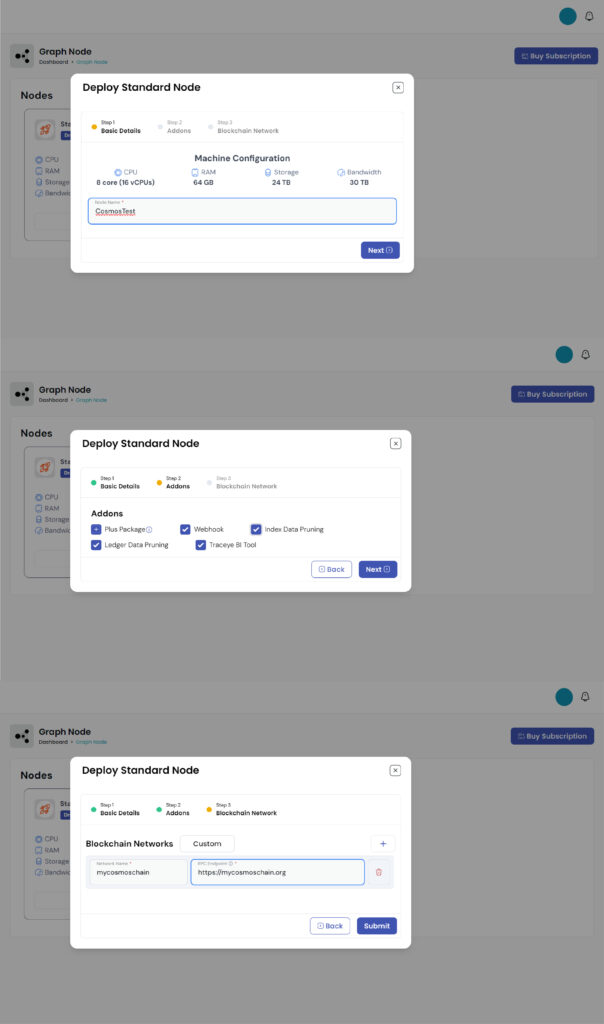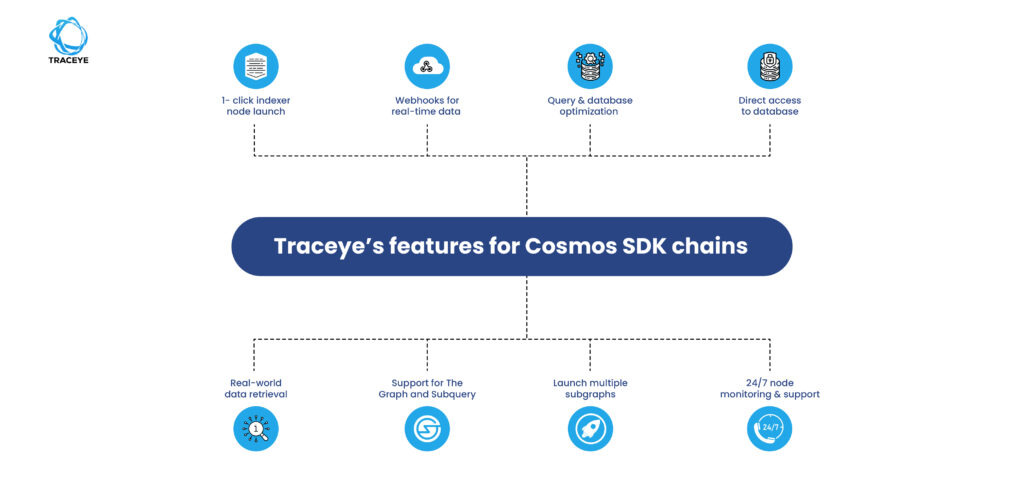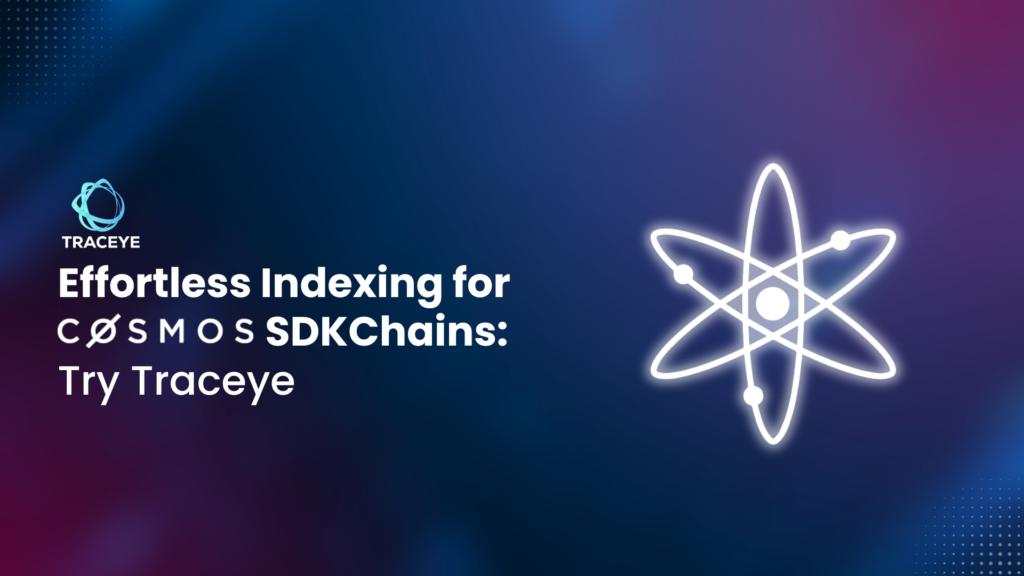Traceye has upgraded its support to offer a dedicated indexer for Cosmos SDK chains. Any Layer1 building with Cosmos SDK can now launch its own dedicated node to pull on-chain data in a more streamlined and efficient way. Also, existing Cosmos SDK chains can upgrade their current data indexer with Traceye’s dedicated indexer. Let’s understand more about what makes Traceye a preferred data indexing solution. We will dive deeper into Traceye’s features and the main advantages it offers for Cosmos SDK chain indexing.
Why Cosmos SDK chains need a dedicated data indexer?
For Cosmos SDK’s high-performance application-specific blockchains, a dedicated indexer offers a range of benefits like unlimited subgraphs/ subquery projects & unlimited queries, hyper-responsiveness, availability, finely-tuned data pipelines, and consistency. Whether your chain relies entirely on the indexed database or it needs real-time data access, a dedicated indexer node will ensure fast response and efficient retrieval on each query. The dedicated indexer from Traceye allows Cosmos CDK chains to leverage all the comprehensive benefits and some additional features. Let’s see what all Cosmos SDK chains can use Traceye:
- Permissioned chains- Private L1 blockchains built with the Cosmos SDK framework can set up a dedicated indexer with Traceye and be used to index data within their ecosystem. This enables such chains to maintain data privacy based on their specific accessibility parameters.
- Permissionless chains- Permissionless (public) Cosmos SDK chains can use Traceye’s dedicated indexer within their ecosystem or they can leverage the node infrastructure to launch subgraphs, making the chain’s data available for community-wide indexing.
How Traceye simplifies data indexing for Cosmos SDK chains?
Below are Traceye’s features that are specific to Cosmos SDK chains. These offerings are designed to accommodate both permissioned and permissionless chains:
Low-code tool for rapid indexer launch:
Traceye offers a low-code node deployment tool that simplifies the complex process of launching indexer nodes. Its 1-click deployment approach saves a notable amount of time that developers would otherwise spend in the programming method of writing codes or adding configurations. From the same dashboard, you can deploy the indexer node, enable necessary add-on services, and set up the automated monitoring system. Here’s a walkthrough:
Complete the node subscription and continue with the deployment process. Then, provide your node’s name, enable desired add-on services or you can opt for ‘Plus Package’ that already includes all the add-on services), and then configure blockchain-level configuration like providing network’s name and adding RPC URL. Upon submission, your indexer node will be live and will be quickly ready to query data.

Webhooks for real-time data:
Building and managing an application on Cosmos requires hands-on access to real-time data. This applies to all types of chains, be it for gaming, DeFi, DePIN applications, AI agents, or even general-purpose use cases. Hence, Traceye’s webhooks feature allows you to retrieve real-time data while also simultaneously querying data from PostgreSQL’s indexed database. As webhooks comes as an add-on service with Traceye, you can enable it in one click while launching your indexer node.
Query & database optimization via pruning:
Another useful add-on on Traceye is index & Ledger data pruning. Both these integrations allow for data pruning through which query & database get optimized, ensuring top-notch performance of your indexer node as well as the subgraphs deployed on it. Pruning retains data for your desired block height and older data get pruned automatically on each event. Through index data pruning, data gets pruned directly from the network’s metadata. Whereas, ledger data pruning works with cron to prune data from databases.
Direct access to database:
To further simplify the data query process, Traceye offers Elastic and Custom Search features. This works by allowing Cosmos SDK chains to retrieve data seamlessly from the indexed databases without needing to run GraphQL queries. Ofcourse, the performance and query speed in this case may impact, but if you see ease, then direct DB access is a feasible option. However, for a comprehensive data query, direct DB features and GraphQL queries can be combined. For this, Cosmos SDK chains need to configure their network to add a Subgraph schema that contains custom entities.
Real-world data retrieval:
Real-world data is extremely important for Cosmos SDK chains. These are mainly the chains built to power interoperable applications that converge on-chain world with the real-world. Knowing this, Traceye has designed a ‘Custom Entities’ feature. Using this, Cosmos chains can query off-chain data through their existing indexer node. Like, a crypto trading platform can get investors’ details like history of investing, credit score, and total holding from a web2-based investment platform. Hence, the process no longer feels an exhaustive and time-consuming thing.
Option for Graph and Subquery nodes:
Traceye aims to be the most versatile and widely used we3 indexing solution. Hence, it has added support for leading data indexing protocols like The Graph and Subquery Network. Cosmos SDK chains looking to launch their custom dedicated with any of these protocols can use Traceye’s 1-click tool. Within minutes node will be ready and it will begin querying the data you want.
Infrastructure for multiple subgraphs:
Each dedicated indexer on Traceye provides infrastructure to launch multiple subgraphs for use-case specific purposes. For example, your indexer node can support payments, gaming, RWA tokenization, media & entertainment, and so on. No matter how frequently these subgraphs make queries or what amount of data they retrieve on each event, Traceye will ensure top-notch performance 24/7.
BI Analytics tool:
The BI analytics at Traceye is created to convert raw on-chain data into clear and actionable insights showcased through dynamic charts, graphs, and tables. Whether your Cosmos SDK chain specializes in DeFi trading, Web3 gaming, or it is a general-purpose Layer1, the BI engine will process complex data to generate detailed, customized data reports that you can explore through an interactive dashboard. Plus, Traceye allows you to integrate these data-driven statistics into your preferred interface for a hyper-immersive analytical experience.
24/7 node monitoring & support:
Traceye’s indexer-node-as-a-service is built to maintain uptime & performance for your indexer nodes. By default, you will get access to a 24/7 graphical monitoring dashboard that keeps a check on your node’s overall performance and product insights about critical parameters like storage status, CPU usage, memory space, RAM utilization, cloud, and more. Whenever the resources go beyond an alarming state, the dashboard will produce real-time alerts. However, Traceye will solve each alert and resolve the issue.
Apart from these features, Traceye also offers support for growth of permissionless Cosmos SDK chains. These chains are basically new and they want a good amount of traction on their network. Traceye provides them infrastructure to set up subgraphs and open their network to the vast community for indexing. This allows Cosmos chains to drive traction and build community without any heavy investment or complicated strategies.

Key benefits of indexing with Traceye:
- Blazing-Fast Indexing: Traceye’s dedicated indexers are optimized to index data at a lightning speed. Likewise, its response to your queries will be superfast with its groundbreaking 5X data backfill technique. No more delays or data lag, all you get is unparalleled efficiency.
- Cost Efficiency: Traceye simplifies the whole process of launching, managing, and scaling your indexer node, lowering down the down significantly.. Forget about additional subscriptions with Traceye’s all-in-one plan has everything your Cosmos SDK chain needs.
- Multiple Subgraphs: A single dedicated indexer node on Traceye can support launch and management of multiple custom subgraphs built for distinct use cases.
- Unmatched Uptime & Availability: Dive into flawless performance of your indexer with Traceye’s 100% uptime guarantee. The 24/7 Enterprise SLA and dedicated infrastructure monitoring ensure that your indexer node is always up and running.
- Valuable Add-Ons: Add-on services on Traceye are designed to Supercharge your data indexing experience. From webhooks to BI analytics tools, and data pruning services, Traceye’s low-cost add-ons quickly enhance your indexer node’s capabilities.
Launch your indexer node on Traceye: Use Zero hassle, DIY Approach
As more projects prefer to build complex, ultra-modern applications, there’s a sharp increase in Cosmos SDK’s adoption. There are already 112+ chains in the Cosmos ecosystem and the list is expanding fast. If you plan to build a Cosmos SDK chain, Traceye can be your ideal solution for data indexing. Its features are more than what we discussed in the article. To learn about Traceye’s capabilities or understand how Traceye works, try it yourself. Also, you can send your queries or suggestions via mail.

Product Director & an intrapreneur with a focus on intersection of technology and business models. Having 10+ years of experience in consulting, software design & architecture, product and project management. Career track follows working on ERPs, Consumer & Enterprise products, stints in AI & Machine Learning and finally settling in decentralization & Blockchain space.
